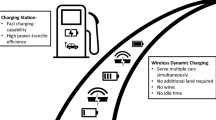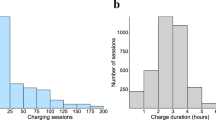Abstract
The rising adoption of plug-in electric vehicles (PEVs) leads to the temporal alignment of their electricity and mobility demands. However, mobility demand has not yet been considered in electricity planning and management. Here, we present a method to estimate individual mobility of PEV drivers at fine temporal and spatial resolution, by integrating three unique datasets of mobile phone activity of 1.39 million Bay Area residents, census data and the PEV drivers survey data. Through coupling the uncovered patterns of PEV mobility with the charging activity of PEVs in 580,000 session profiles obtained in the same region, we recommend changes in PEV charging times of commuters at their work stations and shave the pronounced peak in power demand. Informed by the tariff of electricity, we calculate the monetary gains to incentivize the adoption of the recommendations. These results open avenues for planning for the future of coupled transportation and electricity needs using personalized data.
This is a preview of subscription content, access via your institution
Access options
Access Nature and 54 other Nature Portfolio journals
Get Nature+, our best-value online-access subscription
$29.99 / 30 days
cancel any time
Subscribe to this journal
Receive 12 digital issues and online access to articles
$119.00 per year
only $9.92 per issue
Buy this article
- Purchase on Springer Link
- Instant access to full article PDF
Prices may be subject to local taxes which are calculated during checkout





Similar content being viewed by others
References
Michalek, J. J. et al. Valuation of plug-in vehicle life-cycle air emissions and oil displacement benefits. Proc. Natl Acad. Sci. USA 108, 16554–16558 (2011).
Atia, R. & Yamada, N. More accurate sizing of renewable energy sources under high levels of electric vehicle integration. Renew. Energy 81, 918–925 (2015).
Needell, Z. A., McNerney, J., Chang, M. T. & Trancik, J. E. Potential for widespread electrification of personal vehicle travel in the united states. Nat. Energy 1, 16112 (2016).
Nykvist, B. & Nilsson, M. Rapidly falling costs of battery packs for electric vehicles. Nat. Clim. Change 5, 329–332 (2015).
Melton, N., Axsen, J. & Sperling, D. Moving beyond alternative fuel hype to decarbonize transportation. Nat. Energy 1, 16013 (2016).
Hu, X., Moura, S. J., Murgovski, N., Egardt, B. & Cao, D. Integrated optimization of battery sizing, charging, and power management in plug-in hybrid electric vehicles. IEEE Trans. Control Syst. Technol. 24, 1036–1043 (2016).
DeShazo, J. Improving incentives for clean vehicle purchases in the united states: challenges and opportunities. Rev. Environ. Econ. Policy 10, 149–165 (2016).
Global EV Outlook: Understanding the Electric Vehicle Landscape to 2020 (International Energy Agency, 2013).
Hines, P., Apt, J. & Talukdar, S. Large blackouts in North America: historical trends and policy implications. Energy Policy 37, 5249–5259 (2009).
Brummitt, C. D., Hines, P. D., Dobson, I., Moore, C. & D'Souza, R. M. Transdisciplinary electric power grid science. Proc. Natl Acad. Sci. USA 110, 12159–12159 (2013).
Buldyrev, S. V., Parshani, R., Paul, G., Stanley, H. E. & Havlin, S. Catastrophic cascade of failures in interdependent networks. Nature 464, 1025–1028 (2010).
Brummitt, C. D., D'Souza, R. M. & Leicht, E. Suppressing cascades of load in interdependent networks. Proc. Natl Acad. Sci. USA 109, E680–E689 (2012).
Pahwa, S., Scoglio, C. & Scala, A. Abruptness of cascade failures in power grids. Sci. Rep. 4, 3694 (2014).
McAndrew, T. C., Danforth, C. M. & Bagrow, J. P. Robustness of spatial micronetworks. Phys. Rev. E 91, 042813 (2015).
Mwasilu, F., Justo, J. J., Kim, E.-K., Do, T. D. & Jung, J.-W. Electric vehicles and smart grid interaction: A review on vehicle to grid and renewable energy sources integration. Renew. Sustain. Energy Rev. 34, 501–516 (2014).
Halu, A., Scala, A., Khiyami, A. & González, M. C. Data-driven modeling of solar-powered urban microgrids. Sci. Adv. 2, e1500700 (2016).
Mureddu, M., Caldarelli, G., Chessa, A., Scala, A. & Damiano, A. Green power grids: how energy from renewable sources affects networks and markets. PLoS ONE 10, e0135312 (2015).
Bayram, I. S., Michailidis, G., Devetsikiotis, M., Granelli, F. & Bhattacharya, S. Control and Optimization Methods for Electric Smart Grids 133–145 (Springer, New York, 2012).
Callaway, D. S. & Hiskens, I. A. Achieving controllability of electric loads. Proc. IEEE 99, 184–199 (2011).
Moura, S. J., Fathy, H. K., Callaway, D. S. & Stein, J. L. A stochastic optimal control approach for power management in plug-in hybrid electric vehicles. IEEE Trans. Control Syst. Technol. 19, 545–555 (2011).
Clement-Nyns, K., Haesen, E. & Driesen, J. The impact of charging plug-in hybrid electric vehicles on a residential distribution grid. IEEE Trans. Power Syst. 25, 371–380 (2010).
Tal, G., Nicholas, M., Davies, J. & Woodjack, J. Charging behavior impacts on electric vehicle miles traveled: who is not plugging in? Transp. Res. Rec. 2454, 53–60 (2014).
Harris, C. B. & Webber, M. E. An empirically-validated methodology to simulate electricity demand for electric vehicle charging. Appl. Energy 126, 172–181 (2014).
Lin, Z. Optimizing and diversifying electric vehicle driving range for US drivers. Transp. Sci. 48, 635–650 (2014).
Rajakaruna, S., Shahnia, F. & Ghosh, A. Plug In Electric Vehicles in Smart Grids (Springer, Singapore, 2015).
Tamor, M. A., Moraal, P. E., Reprogle, B. & Milačić, M. Rapid estimation of electric vehicle acceptance using a general description of driving patterns. Transp. Res. C 51, 136–148 (2015).
Hines, P. et al. Understanding and Managing the Impacts of Electric Vehicles on Electric Power Distribution Systems (Univ. Vermont, 2014).
Yuksel, T. & Michalek, J. J. Effects of regional temperature on electric vehicle efficiency, range, and emissions in the united states. Environ. Sci. Technol. 49, 3974–3980 (2015).
Rezaei, P., Frolik, J. & Hines, P. D. Packetized plug-in electric vehicle charge management. IEEE Trans. Smart Grid 5, 642–650 (2014).
Valogianni, K., Ketter, W., Collins, J. & Zhdanov, D. Effective management of electric vehicle storage using smart charging in Proc. 28th AAAI Conf. Artif. Intel. 472–478 (2014).
Ma, Z., Callaway, D. S. & Hiskens, I. A. Decentralized charging control of large populations of plug-in electric vehicles. IEEE Trans. Control Syst. Technol. 21, 67–78 (2013).
Kara, E. C. et al. Estimating the benefits of electric vehicle smart charging at non-residential locations: a data-driven approach. Appl. Energy 155, 515–525 (2015).
Subramanian, A., Garcia, M. J., Callaway, D. S., Poolla, K. & Varaiya, P. Real-time scheduling of distributed resources. IEEE Trans. Smart Grid 4, 2122–2130 (2013).
Yang, L., Zhang, J. & Poor, H. V. Risk-aware day-ahead scheduling and real-time dispatch for electric vehicle charging. IEEE Trans. Smart Grid 5, 693–702 (2014).
Zakariazadeh, A., Jadid, S. & Siano, P. Multi-objective scheduling of electric vehicles in smart distribution system. Energy Convers. Manag. 79, 43–53 (2014).
Garca-Villalobos, J., Zamora, I., San Martn, J., Asensio, F. & Aperribay, V. Plug-in electric vehicles in electric distribution networks: A review of smart charging approaches. Renew. Sustain. Energy Rev. 38, 717–731 (2014).
Alizadeh, M. et al. Optimal pricing to manage electric vehicles in coupled power and transportation networks. IEEE Trans. Control Netw. Syst. 4, 863–875 (2016).
Jiang, S. et al. The TimeGeo modeling framework for urban mobility without travel surveys. Proc. Natl Acad. Sci. USA 113, E5370–E5378 (2016).
Jiang, S. et al. A review of urban computing for mobile phone traces: current methods, challenges and opportunities. In Proc. 2nd ACM SIGKDD Int. Worksh. Urban Computing 2 (ACM, 2013).
Çolak, S., Alexander, L. P., Alvim, B. G., Mehndiratta, S. R. & González, M. C. Analyzing cell phone location data for urban travel: current methods, limitations, and opportunities. Transp. Res. Rec. 2526, 126–135 (2015).
Toole, J. L. et al. The path most traveled: travel demand estimation using big data resources. Transp. Res. Part C 58, 162–177 (2015).
Transportation Secure Data Center (National Renewable Energy Laboratory, accessed 15 January 2015); http://www.nrel.gov/tsdc
National Household Travel Survey (US Department of Transportation, Federal Highway Administration, accessed 1 October 2016); http://nhts.ornl.gov
Schneider, C. M., Belik, V., Couronné, T., Smoreda, Z. & González, M. C. Unravelling daily human mobility motifs. J. R. Soc. Interface 10, 20130246 (2013).
California Plug-in Electric Vehicle Driver Survey Results: May 2013 (California Center for Sustainable Energy, 2013).
California Air Resources Board Clean Vehicle Rebate Project, Rebate Statistics (Center for Sustainable Energy, accessed 5 April 2017); https://cleanvehiclerebate.org/rebate-statistics
Commute Time (Vital Signs, accessed 16 May 2017); http://www.vitalsigns.mtc.ca.gov/commute-time
Saxena, S., Floch, C. L., MacDonald, J. & Moura, S. Quantifying EV battery end-of-life through analysis of travel needs with vehicle powertrain models. J. Power Sources 282, 265–276 (2015).
Wu, X., Dong, J. & Lin, Z. Cost analysis of plug-in hybrid electric vehicles using GPS-based longitudinal travel data. Energy Policy 68, 206–217 (2014).
Yilmaz, M. & Krein, P. T. Review of battery charger topologies, charging power levels, and infrastructure for plug-in electric and hybrid vehicles. IEEE Trans. Power Electron. 28, 2151–2169 (2013).
Workplace Charging Challenge, Mid-program Review: Employees Plug in (US Department of Energy, 2015).
Electric Schedule e-19: Medium General Demand-metered TOU Service (Pacific Gas and Electric Company, 2010).
Merugu, D., Prabhakar, B. S. & Rama, N. An incentive mechanism for decongesting the roads: A pilot program in bangalore. Proc. ACM NetEcon Worksh. (ACM, 2009).
Xu, S., Barbour, E. & González, M. C. Household segmentation by load shape and daily consumption. Proc. 6th ACM SIGKDD Int. Worksh. Urban Computing, 2 (ACM, 2017).
Luo, X., Hong, T., Chen, Y. & Piette, M. A. Electric load shape benchmarking for small-and medium-sized commercial buildings. Appl. Energy 204, 715–725 (2017).
Xydas, E. et al. A data-driven approach for characterising the charging demand of electric vehicles: a UK case study. Appl. Energy 162, 763–771 (2016).
Blondel, V. D., Decuyper, A. & Krings, G. A survey of results on mobile phone datasets analysis. EPJ Data Sci. 4, 10 (2015).
Alexander, L., Jiang, S., Murga, M. & González, M. C. Origin-destination trips by purpose and time of day inferred from mobile phone data. Transp. Res. Part C 58, 240–250 (2015).
Çolak, S., Lima, A. & González, M. C. Understanding congested travel in urban areas. Nat. Commun. 7, 10793 (2016).
Census Data (United States Census Bureau, accessed 15 October 2016); https://www.census.gov/data.html
Fiori, C., Ahn, K. & Rakha, H. A. Power-based electric vehicle energy consumption model: Model development and validation. Appl. Energy 168, 257–268 (2016).
Acknowledgements
We would like to thank ChargePoint for providing the electric vehicle charging data and Airsage for providing the call detail records used in this study. We also would like to thank S. Kiliccote and M. Tabone for their valuable feedback. This work was supported by the Siebel Energy Institute and MIT Energy Initiative.
Author information
Authors and Affiliations
Contributions
Y.X., S.C. and E.C.K. conceived the research and designed the analyses. Y.X., S.C. and M.C.G. performed the analyses and wrote the paper. S.J.M. and M.C.G. provided general advice and supervised the research.
Corresponding author
Ethics declarations
Competing interests
The authors declare no competing interests.
Additional information
Publisher’s note: Springer Nature remains neutral with regard to jurisdictional claims in published maps and institutional affiliations.
Supplementary information
Supplementary Information
Supplementary Figures 1–8, Supplementary Table 1, Supplementary References
Rights and permissions
About this article
Cite this article
Xu, Y., Çolak, S., Kara, E.C. et al. Planning for electric vehicle needs by coupling charging profiles with urban mobility. Nat Energy 3, 484–493 (2018). https://doi.org/10.1038/s41560-018-0136-x
Received:
Accepted:
Published:
Issue Date:
DOI: https://doi.org/10.1038/s41560-018-0136-x
This article is cited by
-
User re-identification via human mobility trajectories with siamese transformer networks
Applied Intelligence (2024)
-
National-scale bi-directional EV fleet control for ancillary service provision
Energy Informatics (2023)
-
Decarbonization potential of electrifying 50% of U.S. light-duty vehicle sales by 2030
Nature Communications (2023)
-
Urban dynamics through the lens of human mobility
Nature Computational Science (2023)
-
Dominant charging location choice of commuters and non-commuters: a big data approach
Transportation (2023)



